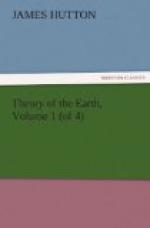If strata composed of such various bodies had been consolidated, by any manner of concretion, from the fluidity of a dissolution, the hard and solid bodies must be found in their entire state, while the interstices between those constituent parts of the stratum are filled up. No partial fracture can be conceived as introduced into the middle of a solid mass of hard matter, without having been communicated from the surrounding parts. But such partial separations are found in the middle of those hard and solid masses; therefore, this compound body must have been consolidated by other means than that of concretion from a state of a solution.
The Spanish marble already described, as well as many consolidated strata of siliceous gravel, of which I have specimens, afford the clearest evidence of this fact. These hard bodies are perfectly united together, in forming the most solid mass; the contiguous parts of some of the rounded fragments are interlaced together, as has already been observed; and there are partial shrinkings of the mass forming veins, traversing several fragments, but perfectly filled with the sparry substance of the mass, and sometimes with parts of the stone distinctly floating in the transparent body of spar. Now, there is not, besides heat or fusion, any known power in nature by which these effects might be produced. But such effects are general to all consolidated masses, although not always so well illustrated in a cabinet specimen.
Thus we have discovered a truth that is confirmed by every appearance, so far as the nature of the subject now examined admits. We now return to the general operation, of forming continents of those materials which had been deposited at the bottom of the sea.
SECTION III.
Investigation of the Natural Operations employed in the Production of Land above the Surface of the Sea.
We seek to know that operation by means of which masses of loose materials, collected at the bottom of the sea, were raised above its surface, and transformed into solid land.
We have found, that there is not in this globe (as a planet revolving in the solar system) any power or motion adapted to the purpose now in view; nor, were there such a power, could a mass of simply collected materials have continued any considerable time to resist the waves and currents natural to the sea, but must have been quickly carried away, and again deposited at the bottom of the ocean. But we have found, that there had been operations, natural to the bowels of this earth; by which those loose and unconnected materials have been cemented together, and consolidated into masses of great strength and hardness; those bodies are thus enabled to resist the force of waves and currents, and to preserve themselves, for a sufficient time, in their proper shape and place, as land above the general surface of the ocean.
We now desire to know, how far those internal operations of the globe, by which solidity and stability are procured to the beds of loose materials, may have been also employed in raising up a continent of land, to remain above the surface of the sea.




